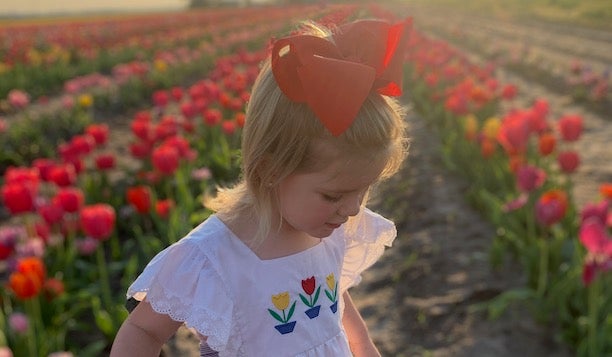Almost time to plant spring flowering bulbs
Published 1:46 pm Friday, October 14, 2022

- Willa Grace Fox playing in the tulips at Terra Ceia Farms. (Kayla Fox)
|
Getting your Trinity Audio player ready...
|
What in the wide world of horticulture is a geophyte?
Well, I didn’t know to be honest. As I was preparing for Master Gardener Training this week I came across the word. In all my vast horticultural Jeopardy knowledge, I had never heard this one before this week. I thought, to be sure this has something to with being in a cave like a stalactite. You know, the things that grow from the roof of a cave that resemble an icicle? That isn’t the case at all as it turns out, a geophyte is a fancy term referring to a group known to us horticulture folks as flowering bulbs. Now flowering bulb refers to a very vast group of plants that includes true bulbs (Tulips), corms (Gladiolus), rhizomes (Cannas), tubers (Caladiums), tuberous roots (Dahlia), and even enlarged hypocotyls (Begonias). Geophyte is a reference that would be synonymous with flowering bulbs.
Now that we have the technical/fancy stuff out of the way, the question we need to answer is, “How do we grow them?” One of the big calls I get this time of year is about whether it is time to plant bulbs or not. The answer is, it depends. In Beaufort County, NC we can grow spring, summer, and fall blooming bulbs. However, this is not a set it and forget it type of thing. For instance, spring blooming bulbs cannot be planted in the spring or they will not bloom. They will not bloom the following spring if you plant them in the summer, in fact, they probably will not bloom at all. If not planted at the correct time, they stand a really good chance of rotting in the soil. Daffodils are spring flowering bulbs as are tulips, crocus, and hyacinths to name a few. A more complete list can be found on the Extension Gardener Plant Toolbox using the find plants tab.
Spring flowering bulbs need to be planted in the fall, typically in November. More specifically, they are planted once the soil temperature gets below 60°F in the fall. Currently, our eight day average is 63.6, so we are almost there but not quite yet.
You can pull this data by going to the NC State Climate office and searching Cardinal: Station Scout within the website. The reason this is important is because the bulbs have a chilling requirement. This means they must accrue a certain number of hours between 35° and 45°F. If they do not reach this number of hours they are often stunted with poor floral displays or no bloom at all. Chilling usually requires a 12 to 16 week period.
As with planting anything, it is important to begin with good planting stock. This is particularly true of bulbs; they contain the entire plant in the bulb. If you were to dissect it you would find roots, leaves, and even the flower already formed. Purchase bulbs without mold, bruising or soft spots. Often times, bad bulbs can be really light as well, these have succumbed to insect damage such as bulb mites. Look for tiny flying insects when you gently shake the bulbs. Also make sure that the bulbs have been stored in a breathable bag before you purchase them. After purchasing, store them in a cool, dark area until planting time. Often times you can find a great variety of flowering bulbs online or in catalogs. We have a bulb grower here in Eastern North Carolina at Terra Ceia Farms in Pantego, NC. There is also Brent & Becky’s that is close by in Virginia. It is definitely worth the day trip to visit either of these farms.
Since bulbs are complete plants, there is no fertilizer applied at planting (unless you are using slow-release). However, if these are perennial bulbs, fertilizing after shoots begin to emerge is a good idea to set the plants up for next season. Deadheading (the process of removing the spent flower) will divert energy from going into seed production to storage in the bulb. This will be better for next year’s floral display if you have planted perennials!
Now how deep to plant your bulbs! Measure the width of the bulbs and them plant them 3 to 4 times as deep as the width. If your bulb measures 2 inches, then it would be planted 6” to 8” deep measuring from the base of the bulb. Plant larger bulbs 3 to 6 inches apart and smaller bulbs 1 to 2 inches apart. There are bulb planters available to help you, some are spring loaded and others are manual.
Happy Fall Y’all!
If you have a question to submit, please email to Gene Fox at gene_fox@ncsu.edu. Having trouble with growing in your home landscape, ask an Extension Master GardenerSMVolunteer (EMGV’s) through the Blacklands Area Horticulture Facebook page. You can also visit the Teaching Garden today Saturday October 15th from 10:00-12:00. Be one of the first 25 folks to visit and receive a free seed packet! Until then, happy gardening!





